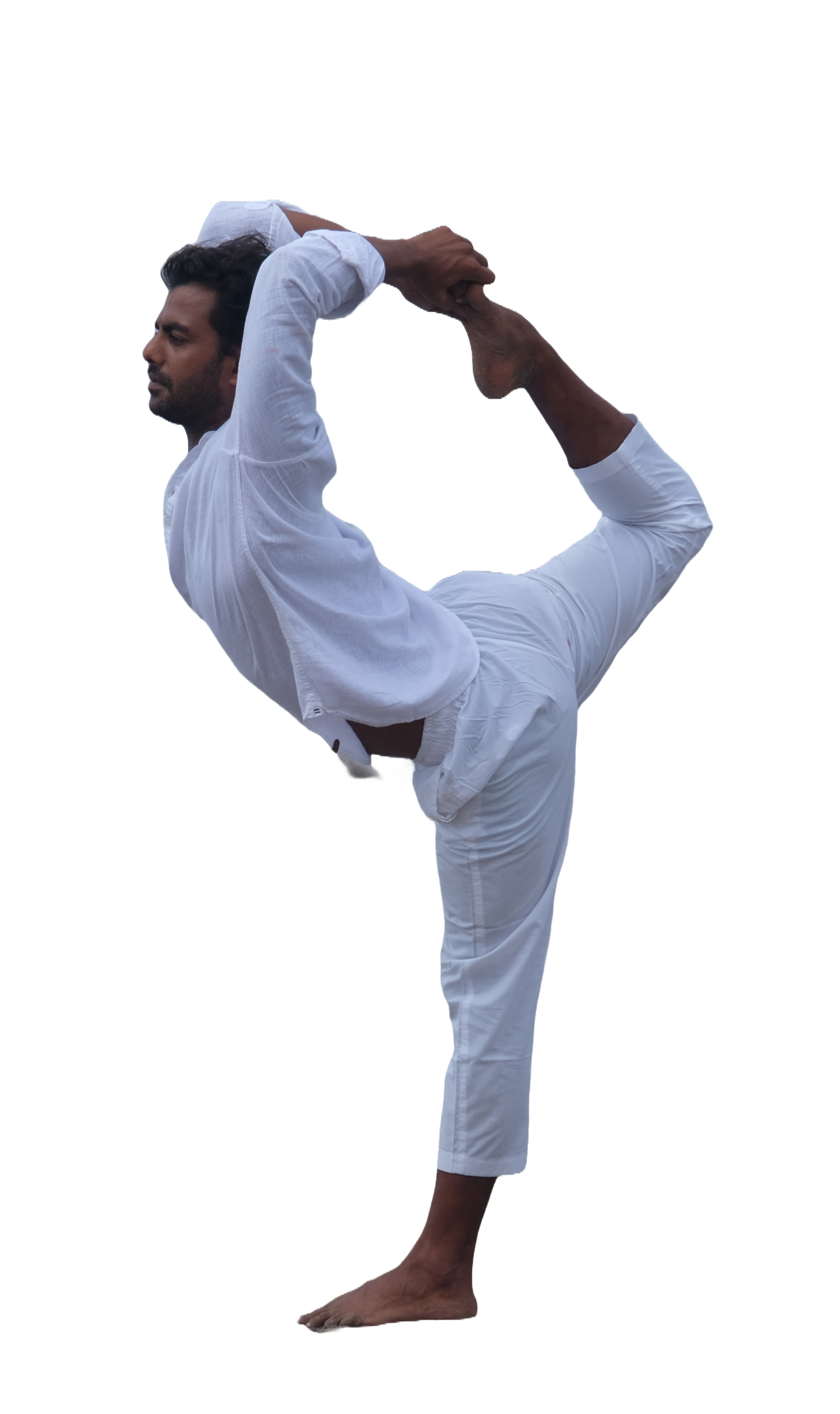
How Yoga Nidra Training Transforms Your Practice
What is Yoga Nidra?
Yoga Nidra is often referred to as “yogic sleep,”. It is a state of conscious deep relaxation that lies between wakefulness and sleep. It is a guided meditation practice designed to induce complete physical, mental, and emotional relaxation. The term “nidra” means sleep in Sanskrit, but Yoga Nidra is more accurately described as a state of deep conscious rest.
Unlike meditation, which often involves concentration or mindfulness, Yoga Nidra guides the practitioner into a state of conscious awareness while the body rests. It is also distinct from sleep as the practitioner remains aware and awake at a subtle level throughout the practice.
Yoga Nidra is a powerful tool for relaxation, self-exploration, and healing and offers a unique combination of restfulness and awareness.
What are the benefits of Yoga Nidra?
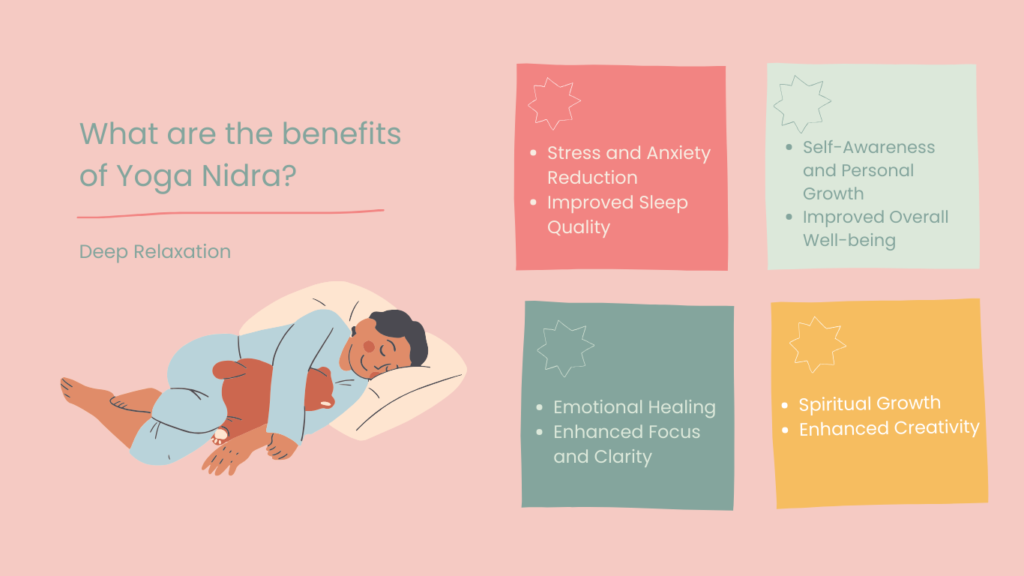
Yoga Nidra offers many benefits, here are some of them.
Deep Relaxation
Physical Relaxation: Yoga Nidra induces a state of deep physical relaxation, helping to relieve muscle tension and reduce overall physical stress.
Mental Calmness: The practice quiets the mind, reduces mental chatter and promotes a state of peace and calm.
Stress and Anxiety Reduction
Cortisol Reduction: Regular practice lowers cortisol levels, a stress hormone. That helps in reducing stress and anxiety.
Nervous System Regulation: Yoga Nidra activates the parasympathetic nervous system, which is responsible for rest and digestion, countering the effects of stress.
Improved Sleep Quality
Better Sleep Patterns: Practicing Yoga Nidra can help improve sleep quality and is therapeutic for insomnia by calming the nervous system and mind.
Restfulness: 30 minutes of Yoga Nidra can provide rest equivalent to several hours of sleep, making it beneficial for those who struggle with sleep.
Emotional Healing
Processing Emotions: Yoga Nidra helps to access and process deep-seated emotions and traumas in a safe, conscious manner.
Emotional Balance: The practice promotes emotional stability by cultivsting a sense of acceptance and understanding.
Enhanced Focus and Clarity
Mental Clarity: The deep relaxation achieved through Yoga Nidra increases focus and improves mental clarity.
Increased Concentration: By calming the mind and reducing mental clutter, Yoga Nidra improves concentration and cognitive function.
Self-Awareness and Personal Growth
Inner Exploration: Yoga Nidra facilitates a deeper connection with the self, allowing for profound inner exploration and personal growth.
Intention Setting: The practice involves setting a Sankalpa, or intention, which can lead to positive life changes and personal development.
Improved Overall Well-being
Physical Health: The deep rest and relaxation can boost the immune system, lower blood pressure, and improve overall physical health.
Mental and Emotional Well-being: The practice helps manage depression, anxiety, and other mental health issues by promoting a balanced state of mind.
Spiritual Growth
Connection to Higher Self: For those inclined towards spirituality, Yoga Nidra can deepen the connection to the higher self and cultivates a sense of unity and oneness.
Mindfulness and Presence: The practice enhances mindfulness and the ability to live in the present moment.
Enhanced Creativity
Creative Insights: The deep state of relaxation can unlock creative insights and solutions to problems.
Who can practice Yoga Nidra?
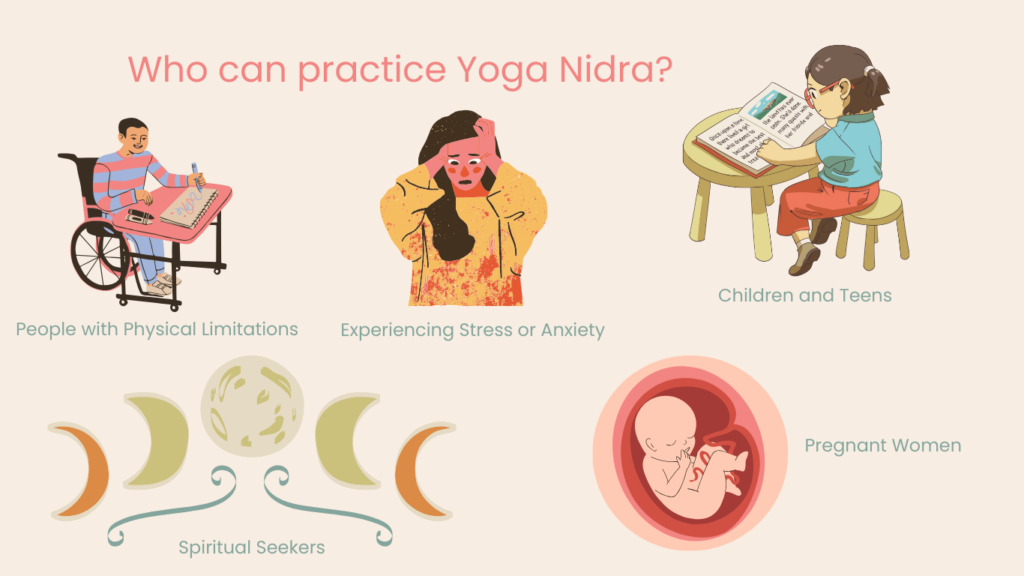
Yoga Nidra is accessible to people of all ages, physical abilities, and experience levels, making it a versatile and inclusive practice. To give you an idea for whom Yoga Nidra is beneficial, we have made a list here.
Beginners to Meditation and Yoga
Yoga Nidra is a guided practice, making it easy for beginners to follow along. It doesn’t require any advanced knowledge of Yoga poses or meditation techniques. It’s an excellent entry point for those new to meditation or Yoga, offering a gentle way to experience deep relaxation.
People with Physical Limitations
Since Yoga Nidra is practiced lying down in a comfortable position (like Savasana), it is suitable for individuals with physical limitations, injuries, or chronic pain. Elderly individuals, those recovering from surgery, or people with disabilities can practice Yoga Nidra without straining their bodies.
Individuals Experiencing Stress or Anxiety
Yoga Nidra is particularly beneficial for those dealing with high levels of stress or anxiety, as it promotes deep relaxation and helps to calm the nervous system. The practice can be a powerful tool for managing anxiety and panic attacks, offering a safe space to relax and release tension.
People Struggling with Sleep Issues
Those who struggle with insomnia or other sleep disorders may find Yoga Nidra helpful in improving sleep quality by inducing a state of deep relaxation and mental calmness. For people who have trouble napping, Yoga Nidra can offer similar restfulness and rejuvenation as sleep.
Busy Professionals and Students
Busy individuals who need a quick, effective way to relax and recharge can benefit from Yoga Nidra. Professionals and students can use Yoga Nidra to enhance mental clarity, focus, and productivity by reducing mental fatigue.
Children and Teens
Yoga Nidra can be adapted for children and teens, helping them manage stress, anxiety, and emotional challenges. It can also improve focus and concentration, which can help them to stay focused in school.
Individuals Seeking Emotional Healing
Those dealing with trauma, grief, or unresolved emotions may find Yoga Nidra helpful in processing and releasing emotional pain in a gentle and supportive manner. It is often used in therapeutic settings to support mental health and emotional well-being.
Spiritual Seekers
People interested in deepening their spiritual practice can use Yoga Nidra to explore their inner world and experience states of consciousness beyond the ordinary waking state.
Pregnant Women
Yoga Nidra is a safe and effective way for pregnant women to relax, reduce stress, and connect with their bodies and their babies. It can be especially beneficial during times when physical Yoga poses may be uncomfortable.
Athletes
Athletes can use Yoga Nidra to enhance recovery, improve focus, and manage performance anxiety.
What is a Yoga Nidra teacher training?

A Yoga Nidra teacher training is a specialized program designed to train individuals in the art and science of guiding others through Yoga Nidra, that induces deep relaxation and conscious awareness.
This training equips participants with the knowledge, skills, and confidence needed to teach Yoga Nidra to diverse groups, whether in Yoga studios, wellness centers, therapy settings, or private practice.
Understanding Yoga Nidra
Theory and Philosophy: Participants learn the foundational principles of Yoga Nidra, including its origins, purpose, and the philosophical concepts behind the practice.
Stages of Yoga Nidra: The teacher training Yoga Nidra covers the different stages of Yoga Nidra, such as body scanning, breath awareness, visualization, and intention setting (Sankalpa).
Practical Experience
Guided Practice: Trainees participate in multiple Yoga Nidra sessions to experience the practice from a student’s perspective.
Teaching Practicum: Participants have opportunities to practice leading Yoga Nidra sessions, receiving feedback from instructors and fellow students.
Anatomy and Physiology
Understanding the Body and Mind: The Nidra Yoga teacher training often includes lessons on the nervous system, stress response, and how Yoga Nidra affects the body and mind. This knowledge helps teachers guide others safely and effectively.
Script Development
Creating Yoga Nidra Scripts: Trainees learn to craft their own Yoga Nidra scripts, tailoring the practice to meet the needs of different audiences, such as beginners, or those dealing with stress or trauma.
Adapting the Practice: The Yoga Nidra teacher training may include how to adapt Yoga Nidra for different settings (e.g., group classes, private sessions, or therapeutic contexts).
Teaching Techniques
Voice and Tone: Participants learn how to use their voice effectively, including tone, pace, and modulation, to guide others into deep relaxation.
Holding Space: Training includes how to create a safe and supportive environment for students, allowing them to fully relax and engage with the practice.
Certification
Completion Requirements: Most programs require the completion of certain hours of study, practice teaching, and possibly a final exam or project to receive certification.
Who can join a Yoga Nidra teacher training?
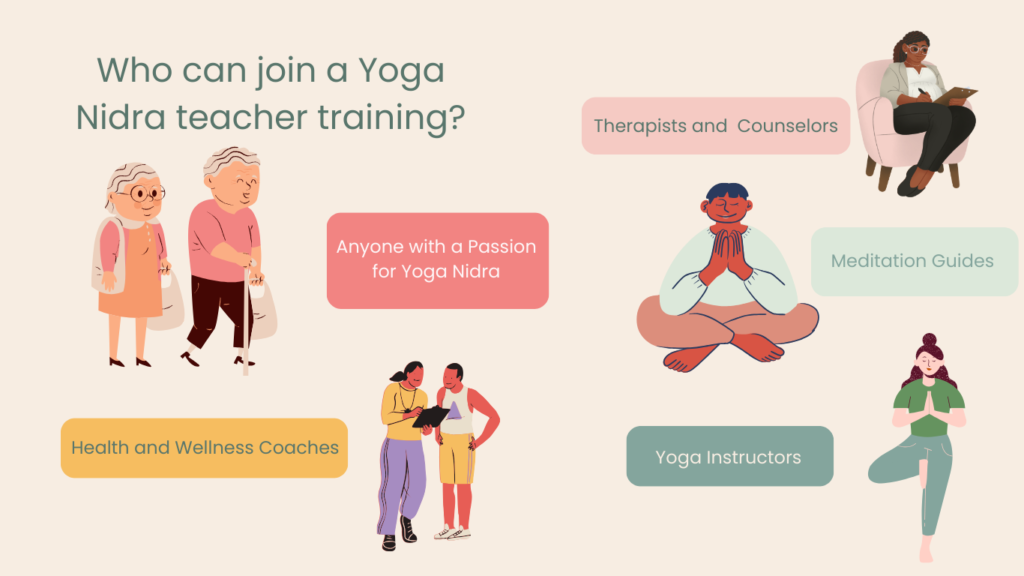
Yoga Instructors: Those who already teach Yoga and want to expand their offerings with Yoga Nidra.
Meditation Guides: Individuals interested in leading guided meditation practices in various settings.
Therapists and Counselors: Mental health professionals looking to integrate Yoga Nidra into their therapeutic work.
Health and Wellness Coaches: Professionals who want to offer relaxation and stress management techniques to their clients.
Anyone with a Passion for Yoga Nidra: Even those not seeking to teach might take the training to deepen their personal practice and understanding of Yoga Nidra.
What Yoga Nidra trainings do we offer?
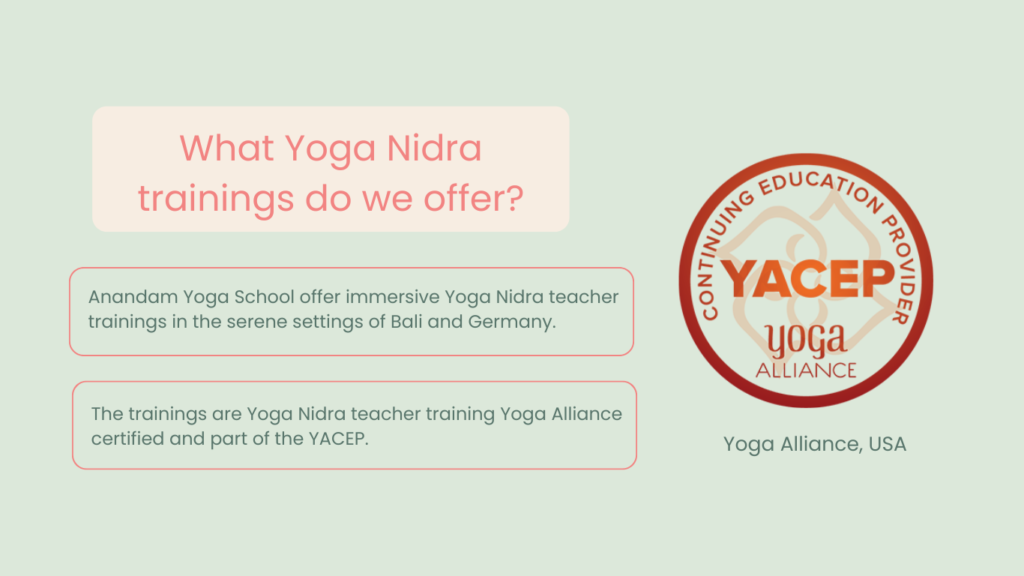
After exploring the world of Yoga Nidra a little bit you may find yourself drawn to learning more about this practice and sharing it with others. Embarking on a Yoga Nidra teacher training is an incredible opportunity to deepen your own practice while learning to guide others into states of deep relaxation and healing.
If you’re ready to take this journey, we at Anandam Yoga School offer immersive Yoga Nidra teacher trainings in the serene settings of Bali and Germany. The trainings are Yoga Nidra teacher training Yoga Alliance certified and part of the YACEP. They are designed to provide you with the skills, knowledge, and confidence needed to become a proficient Yoga Nidra teacher.
Find more information about the curriculum of our Yoga Nidra teacher training Bali and our Yoga Nidra teacher training in person in Germany on the course pages.
We would love to welcome you and unveil the secrets of Yoga Nidra!
Our Yoga Nidra Courses :
Popular Courses in Bali
200 hour Yoga Teacher Training in Bali | 300 hour Yoga Teacher Training in Bali | 500 hour Yoga Teacher Training in Bali | 50 Hours Yin Yoga Training in Bali | 50 hours Pranayama Training in Bali | 50 hours Yoga Nidra Training Bali | 50 hours Arm Balancing Training Bali | 100 hour Ashtanga Training Bali
Popular Courses in Germany
200 hour Yoga Teacher Training in Germany | 300 hour Yoga Teacher Training Germany | 50 Hour Yin Yoga Training Germany | 50 Hour Pranayama Training Germany | 50 hour Yoga Nidra Training Germany | 50 Hour Arm Balancing Training | 100 hour Ashtanga Training Germany

